Unit 4 Body language-Using language
文档属性
| 名称 | Unit 4 Body language-Using language | 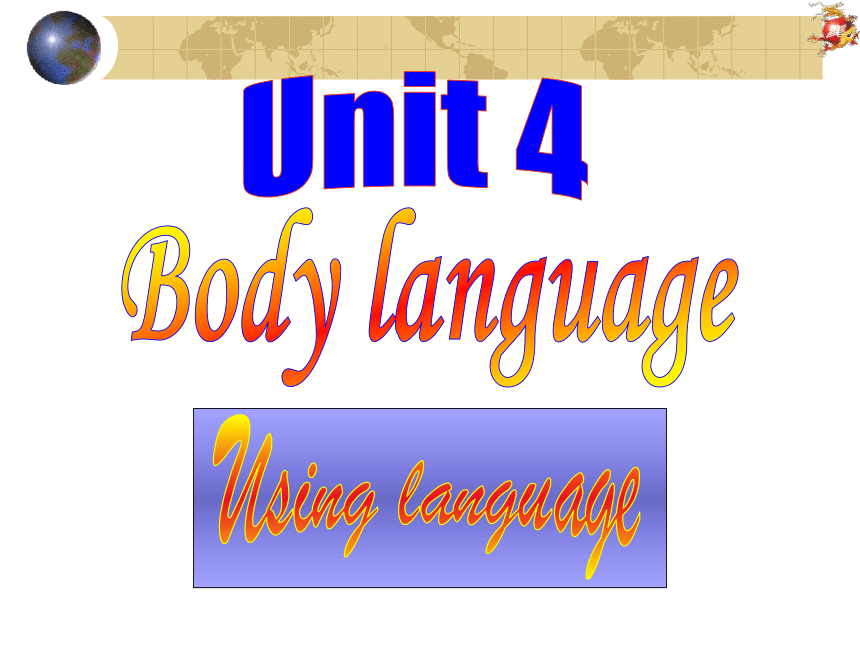 | |
| 格式 | rar | ||
| 文件大小 | 5.0MB | ||
| 资源类型 | 教案 | ||
| 版本资源 | 人教版(新课程标准) | ||
| 科目 | 英语 | ||
| 更新时间 | 2011-12-09 11:55:15 | ||
图片预览

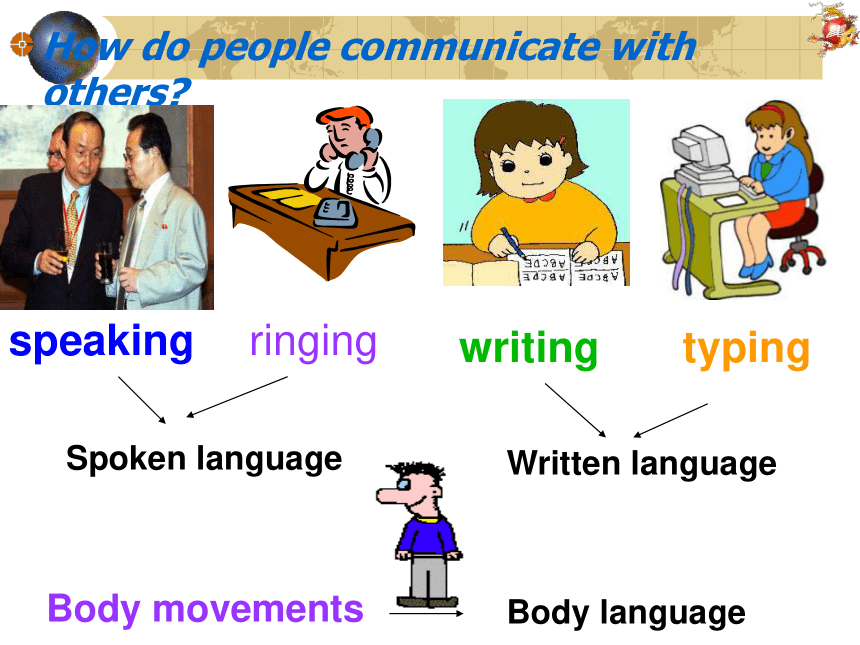
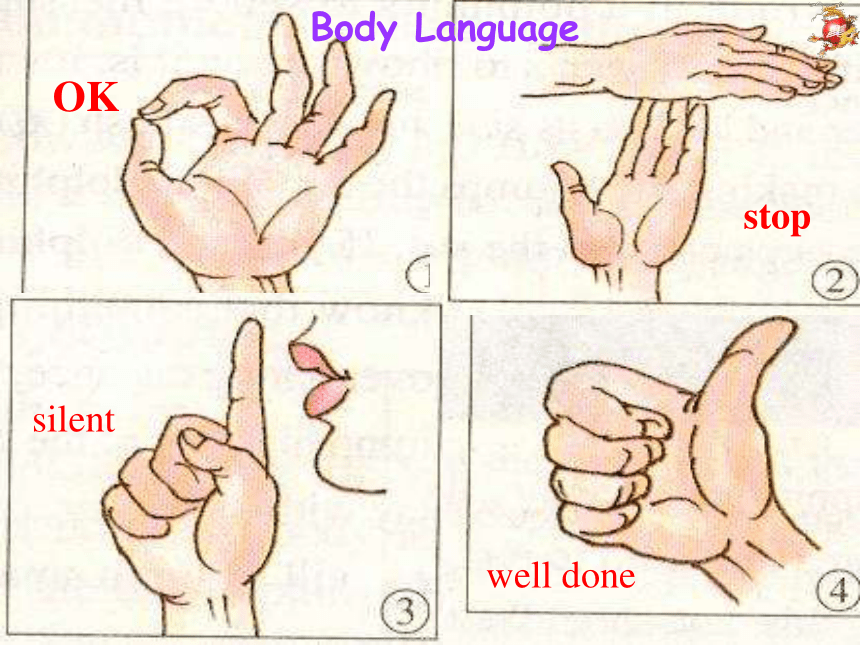
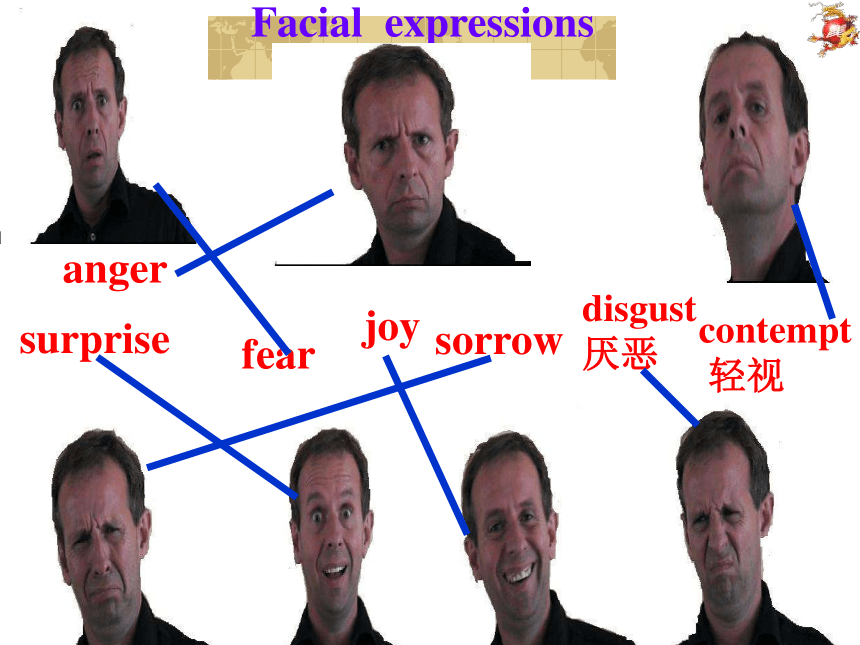
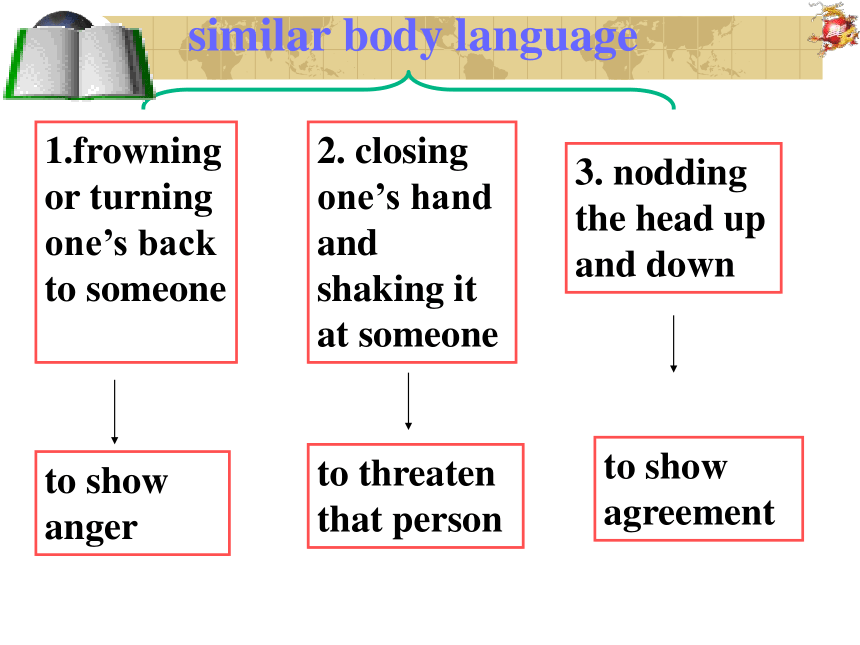
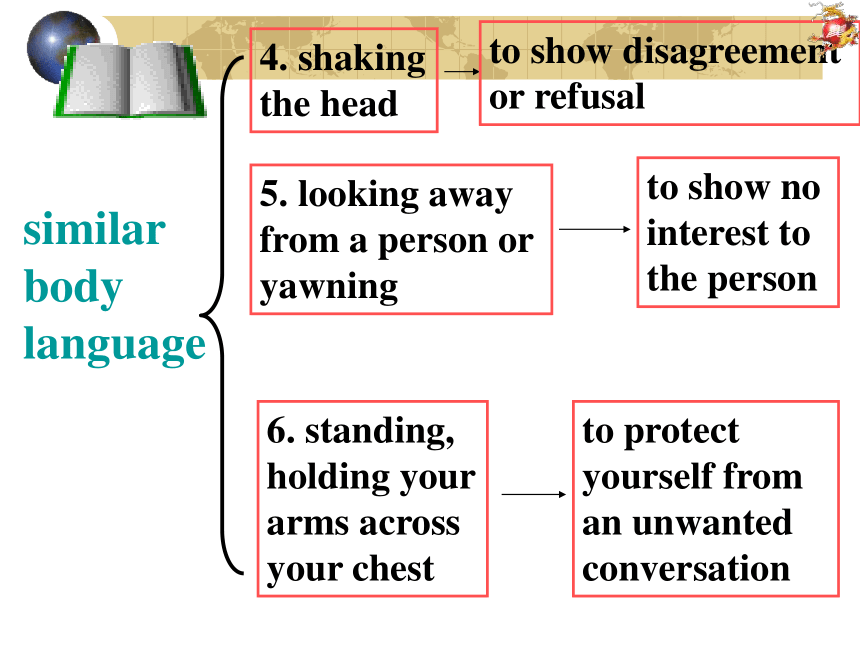
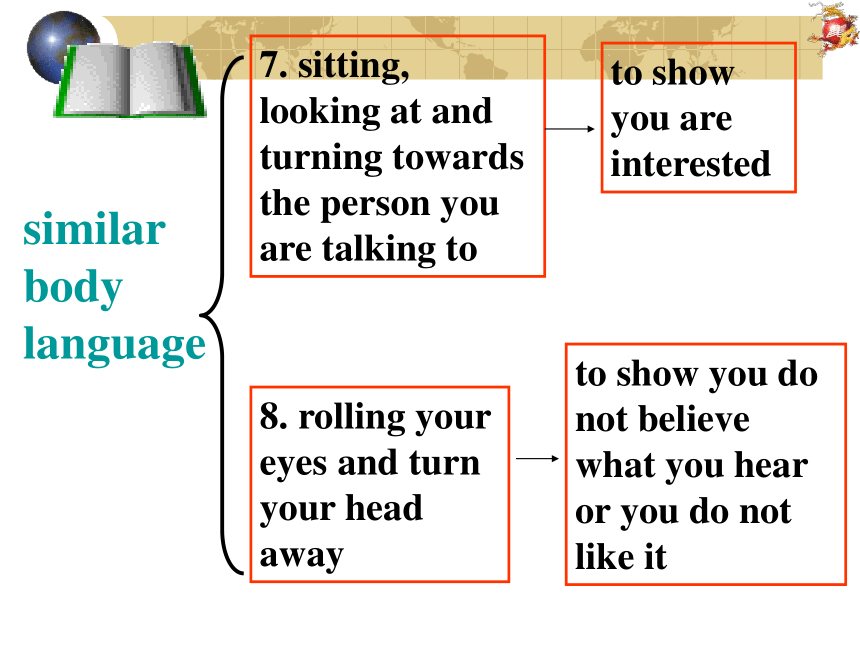
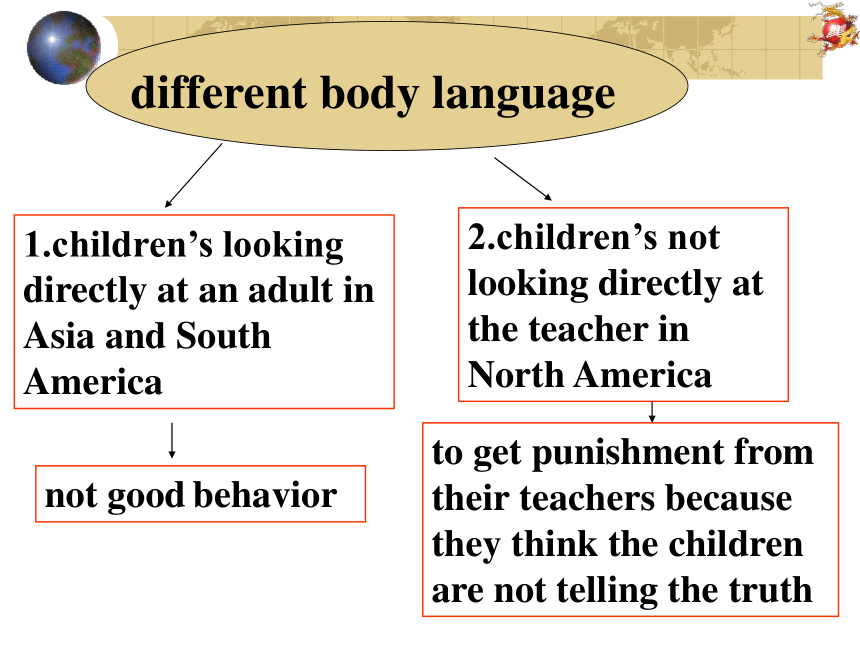
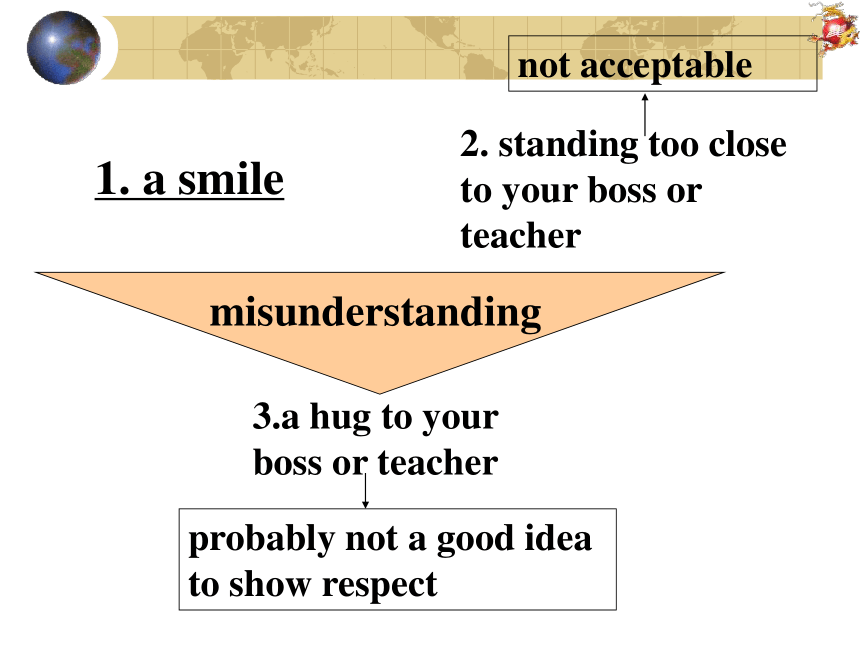
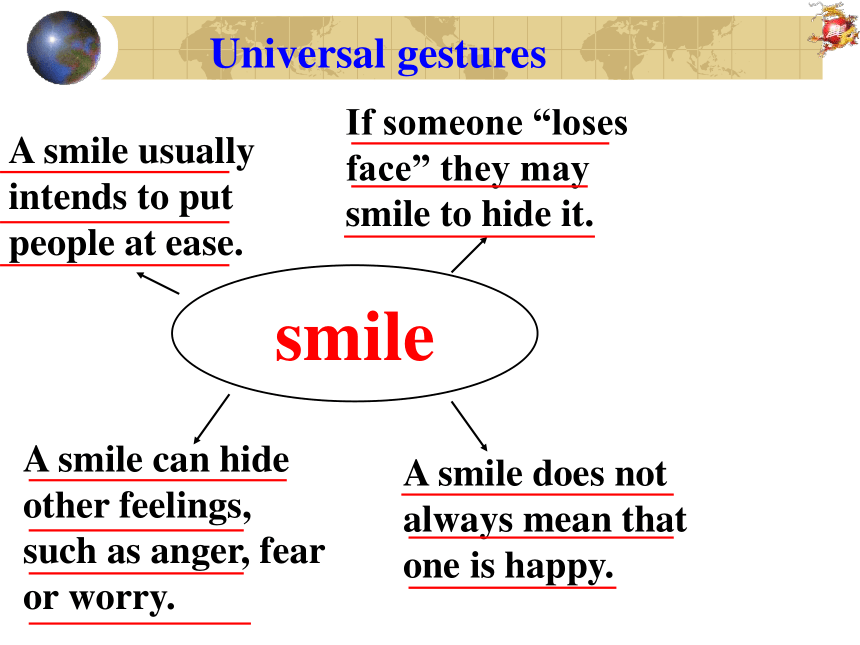
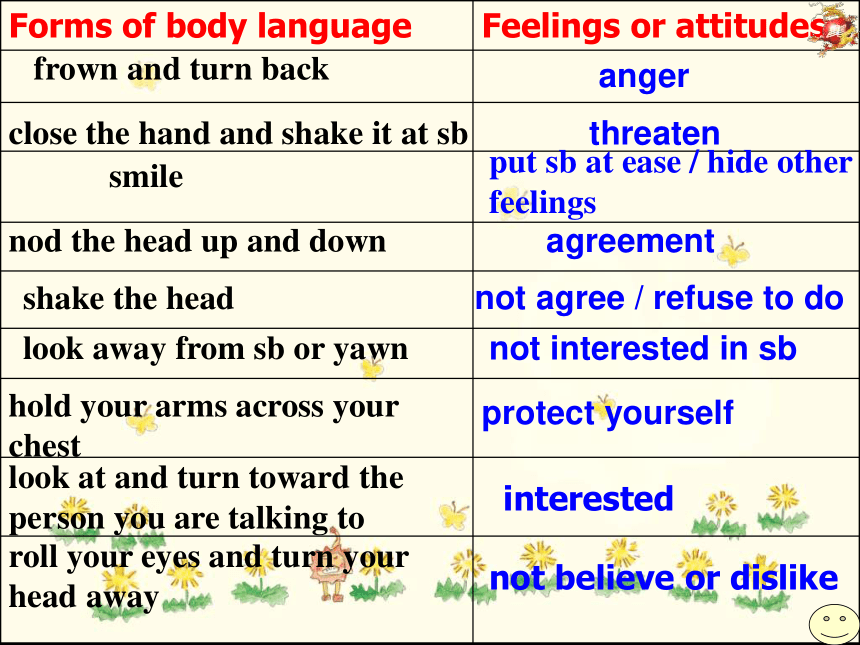
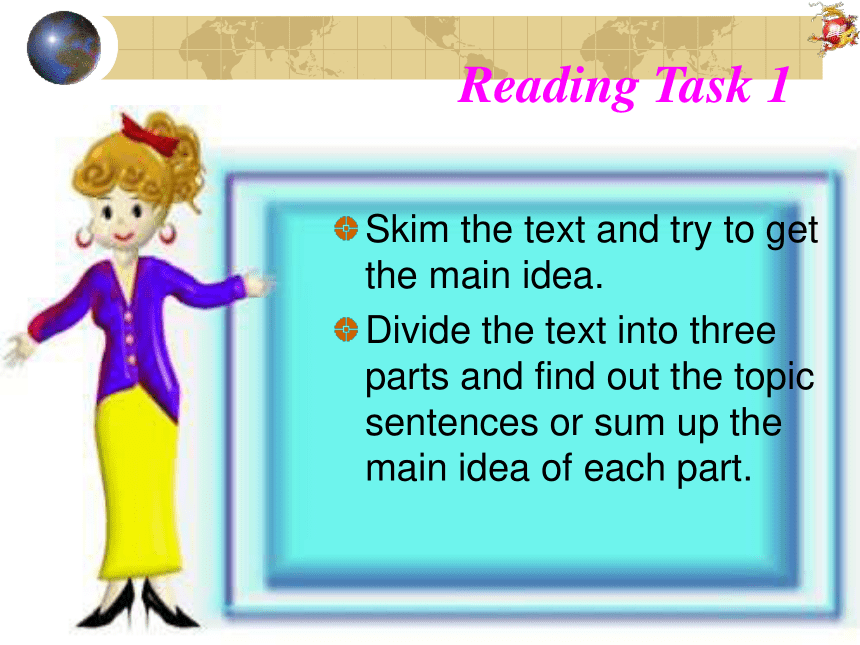
文档简介
(共98张PPT)
How do people communicate with others
speaking
ringing
writing
typing
Spoken language
Written language
Body movements
Body language
Body Language
OK
stop
silent
well done
Facial expressions
anger
fear
joy
sorrow
contempt
轻视
surprise
disgust
厌恶
similar body language
1.frowning or turning one’s back to someone
to show anger
2. closing one’s hand and shaking it at someone
to threaten that person
3. nodding the head up and down
to show agreement
similar body language
4. shaking the head
to show disagreement or refusal
5. looking away from a person or yawning
to show no interest to the person
6. standing, holding your arms across your chest
to protect yourself from an unwanted conversation
similar body language
7. sitting, looking at and turning towards the person you are talking to
8. rolling your eyes and turn your head away
to show you are interested
to show you do not believe what you hear or you do not like it
different body language
1.children’s looking directly at an adult in Asia and South America
not good behavior
2.children’s not looking directly at the teacher in North America
to get punishment from their teachers because they think the children are not telling the truth
misunderstanding
2. standing too close to your boss or teacher
3.a hug to your boss or teacher
not acceptable
probably not a good idea to show respect
1. a smile
smile
Universal gestures
A smile does not always mean that one is happy.
A smile can hide other feelings, such as anger, fear or worry.
If someone “loses face” they may smile to hide it.
A smile usually intends to put people at ease.
Forms of body language Feelings or attitudes
frown and turn back
close the hand and shake it at sb
smile
nod the head up and down
shake the head
look away from sb or yawn
hold your arms across your chest
look at and turn toward the person you are talking to
roll your eyes and turn your head away
anger
threaten
put sb at ease / hide other feelings
agreement
not agree / refuse to do
not interested in sb
protect yourself
interested
not believe or dislike
Reading Task 1
Skim the text and try to get the main idea.
Divide the text into three parts and find out the topic sentences or sum up the main idea of each part.
Main idea of each part:
Part 1 (Para 1) Body language shows all kinds of feelings, wishes and attitudes and sometimes more important than spoken language.
Part 2 (Para 2-Para6) Denotation and examples of some body language.
Part 3 (Para 7-Para8) There are differences in body language, it’s important for us to know them.
Reading Task 2
Scan the text and decide whether the following statements are true or false.
If it is false, explain why it is wrong.
1. Body language is never as important as spoken language.
sometimes more---than
2. If you are angry at a person, you might turn your back to him or her.
3. You can threaten a person by refusing to speak.
You can threaten a person by closing your hand and shaking it at him or her.
4. If you stand with your arms across your body, you are always protecting yourself from being physically attacked.
If you stand with your arms across your body, you may be protecting yourself from an unwanted conversation.
5. If you sit looking away from a person, or with your back turned, you are saying you are not interested in that person.
6. You should not greet your new boss by giving her or him a hug.
7. Body language is the same all over the world.
Body language is sometimes the same, but it is sometimes quite different.
8. Most people can understand each other if they try.
True or false statements:
( ) 1. Body language is never as important
as spoken language.
( ) 2. If you are angry at a person, you might turn your back to him or her.
( ) 3. You can threaten a person by
refusing to speak.
( ) 4. If you stand with your arms across your body, you are always protecting yourself from being physically attacked.
F
T
F
F
True or false statements:
( ) 5. If you sit looking away from a person,
or with your back turned, you’re saying you’re not interested in that person.
( ) 6. You should not greet your new boss by giving her or him a hug.
( ) 7. Body language is the same all over the world.
( ) 8. Most people can understand each other if they try.
F
T
T
T
Read the passage again and try to discuss the following questions in a small group. Refer the correct statements above to help you
How can we know others’ feelings, even if they don’t speak to us
2. Why should we be careful of our own body language
3. Why is it important to watch others as well as listen to them
How can we know others’ feelings, even if they don’t speak to us
We can watch the expressions on people’s faces; we can look at whether they face us or look away; we can observe how they hold their arms and hands; we can see whether they are close to or far away from others. Are they smiling,frowning, shrugging, holding their arms in front of them or touching other people
2. Why should we be careful of our own body
language
We should be careful of our own body language
as we must be sure not to be impolite in other
cultures, and. we need to communicate without
being misunderstood.
3. Why is it important to watch others as well as
listen to them
We need to watch other people because they may be communicating one idea in words and a different one in body language.
Body language is used by people to _______ their thoughts and opinions and to _________ with each other. When you talk with others, you are not just using words, but also using facial expressions as well as ________. Just like words, body language _____ from culture to culture. For example, in many countries, shaking one’s head means “no” while ______ means “yes”.
express
communicate
gestures
varies
nodding
However, in some parts of the world, the gestures have the _______ meaning. Although there’re many interpretations of our body language, some gestures are _________. The _____ is the best example. It can be used to express almost any ________.
opposite
universal
smile
emotion
Language points
1. similar adj. 类似的, 相似的
similarity n. 相似,类似
similarly adv. 相似地
* be similar to… 与……相似,类似于
Eg: We have similar taste in music.
我们在音乐方面的爱好相近。
My opinion is similar to yours.
我的想法与你的类似。
2. intend (plan, mean to do) 打算,想要企图
(1)I __________ use the facial expression to
show my satisfaction. 一般人作主语
(2) The facial expression ___________ show
my satisfaction. 一般物作主语
(3). The book ____________ teachers.
这种书是给老师(设计的)
(4).They ___________ the plan should be put into
practice within the year.
他们打算在本年内实行该计划。
intend to
is intended to
is intended for
intend that
3. You should not stand too close to him or her and should stand with your hands a little open to show that you are willing to listen.
他习惯于开着门睡觉。
He is used to sleeping with the door open.
我不能去度假,因为有很多东西等着我处理。
With so many things to deal with, I can’t go on holiday.
他没有关灯就离开教室啦。
He left the classroom with the light on.
4. We can often be wrong about each other, so it is an amazing thing that we understand each other as well as we do.
事实证明我们都误解他啦。
The fact proves that we were all wrong about him.
It was natural that he should think so.
It is a/an amazing/surprising/exciting thing that sb (should) do 后经常跟虚拟语气
It is really a surprising thing that the girl marry so early.
他如果那样想,就很正常啦。
如果女孩这么早结婚会令人很吃惊的。
5.Explain the following phrases.
spoken language
facial expression
be intended to
be wrong about sb
turn toward sb
look away from
口头语言
面部表情
有意干……
误解某人
转向某人
不看,不注视
Homework:
Read the passage in Reading Task on P66 and then finish the exercise on P67.
The Open Hand- A Universal Sign
universal gestures
I am tired
I am full
I am hungry
press palms/rest
your head on it/
eyes closed
move hand
in circle
pat stomach
Look at the pictures below and think:
In what situation do they shake hands
This information was found in the notes left by an anthropologist. Arrange and organize it so that it can be used to write a summary.
1. It can be
2. Many Asian people
3. If we show an open hand
4. The right hand
5. People shake their hands
6. To show respect Is usually used
dangerous for you
do not usually
Muslim people
it means that
when meeting people physically touch
will touch their heart and mouth
because it is almost always
to meet people
to show that
we are not holding they can be trusted.
strangers.
anything dangerous.
the stronger.
when greeting someone.
you do not know.
Possible answers:
It can be dangerous for you to meet people you do not know.
Many Asian people do not usually physically touch strangers.
If we show an open hand, it means that we are not holding anything dangerous.
The right hand is usually used because it is almost always the stronger.
People shake their hands when meeting people to show that they can be trusted.
To show respect Muslim people will touch their heart and mouth when greeting someone.
Translate the following sentences:
a.如果他们不来,怎么办呢?
b.倘使我们不能按时到达,将会这样?
c.如果我们在不熟悉的地方碰到陌生人,那该怎么办?
Difficult point:
What if we don’t know who the new person is
What if … 倘使…将会怎样?
What if we are meeting a stranger in an
unfamiliar place
What if we can’t get there on time
What if they do not come
Exercises (P.63)
1. When you _____, you move your head up and down, usually to show agreement.
2. If you _____ someone, you put your arms round them and hold them close to you.
3. When you ______ someone you touch his or her with your lips as a sign of love.
nod
hug
kiss
Choose the verbs on the right to complete each of the sentences below.
nod
hug
kiss
4.When you ____________ hands with someone, you grasp their hand as a way of greeting them.
5.When you __________, the corners of your mouth move outwards and slightly upwards because you are pleased or amused.
6. When you ______, you hit your hands together loudly to show your appreciation.
7.If you ________ someone, you hit them with the palm of your hand.
8. When you _________ your head, you move it from side to side in order to say “no”.
clap
shake
slap
smile
clap
shake
shake
smile
slap
Read through the words in the box and label each of the pictures below . Use a dictionary to help you with the words you don’t know.
1.blow a kiss 7. shake one’s head
2.frown 8.shrug one’s shoulders
and make a face
3.nod 9.yawn
4.pout 10. stare
5.raise one’s eyebrows 11.wave
6.scratch one’s head 12. wink
stare
frown
wink
blow a kiss
scratch one’s head
shrug one’s shoulders and make a face
shake one’s head
wave
nod
raise one’s eyebrows
pout
yawn
Check the translation: Ex 3 WB.
1.当你走近一个人的时候,你的面部表情会表现出你是否友好。(approach;facial;expression)
When you approach someone,your facial expression show if you are friendly or not.
2. 对于在舞台上他们将怎样把这本书以喜剧的形式表现出来,我感到非常好奇。 (curious;comedy;represent)
I am curious to know how they will represent
this book as a comedy on the stage.
They are likely to misunderstand each other, and not reach an agreement on the matter.
4.我惊讶地发现这两种相似的手势表达了如此不同的意 见。(similar;gesture;express)
I am astonished at how the two similar gestures can express such different meanings.
5. 一般说来,人们愿意坐火车而不坐飞机以避免过大的开销。( in general; avoid)
In general,people prefer to take a train instead of the airplane to avoid spending so much on travel.
3.他们彼此很可能会产生了误会,因而可能在这个问题上
也不会达成一致。(likely to; misunderstand; agreement)
Homework:
.Retell the text.
.Write down five different
kinds of body language
used in our daily life.
Please guess what happened to Lin Pu from their body language in the picture.
Look at the pictures of the story and arrange them by numbers in the correct order to tell the story.
correct order:___ ___ ___ ___ ___ ___
2
1
3
4
6
5
Listen again and then fill in the blanks in the dialogue.
What Lin Pu says and does;
Attention
What the cyclist says and does;
What the policeman says and does.
Lin Pu has just got his driver’s _______. He has a car too, but he isn’t too happy with it. It is an old car that he bought from his __________ , who smiled happily when Lin Pu paid him.
He is driving for the ____time in the city, and is very _______. Taxis are going in every direction. The bicycle riders are not looking at him, and he is beginning to think that he________ have bought the car.
licence
brother-in-law
first
nervous
shouldn’t
Suddenly, the traffic light turns____. He can’t stop in time and turns his left to _____ hitting the car in front of him. Crash! He hits a bicycle and _____ over a basket full of apples. And there is a policeman, walking toward him.
C – Cyclist P– Policeman L– Lin Pu
Cyclist: Look what you did! All my apples
are on the road! What am I going to ____in the market You must ___ me for them!
Policeman: Well, what’s the matter here
Don’t you know you can’t be in two places at
once Stay in your lane! Watch the______!
red
avoid
knocks
sell
pay
traffic
Pay attention to the lights, and stop when you are apposed to! Where do you think you are going You’ll have pay a ______ for this.
Lin Pu: I’m sorry. I didn’t see this man. I was trying not to hit the car in front of me. I just got my licence and I’m not used to ________in the city.
Cyclist: I don’t care if you are used or not! What are you going to do about my apples (to the policeman) Can’t you make him pay me
fine
driving
Policeman: I can make him pay a fine. I hope you didn’t pay much for this car. You would be able to buy a ______car with the money you will pay for your fine.
Lin Pu: I don’t have any money. I _____ all my money on my car. What can I do
Cyclist: You can ____ __ my apples.
Policeman : You can sell the car--- if you can find somebody to buy it. You have to pay this fine by the end of the month.
Lin Pu: Oh, dear! Why did I ever want a car
better
spent
pick up
You may not…
Always stay…
He must …
Be careful when …
Work in groups of three and use some verb phrases or sentences to describe each picture. Be prepared to act it out using spoken language as well as body language. The following words may help you.
You must…
Never… / Do not …
Watch out …
You should never …
the brother-in-law smiling very happily and rubbing his hands with joy.
bought a car from his brother-in-law
Lin Pu and his brother-in-law
Money changing hands,
smiling faces,
shaking hands,
driving nervously for the first time
reacting to crash.
Lin Pu
Nervously looking around,
reacting to traffic,
sudden left turn,
Lin Pu hit a bicycle
Lin Pu knocked over a basket full of apples
Lin Pu and a cyclist
The cyclist
My hand hurt.
Come here.
shaking his fist (closed hand ) at Lin Pu ,
Lin Pu ,the cyclist and a policeman
L and the cyclist quarreled, and a policeman walked towards them.
angry, shouting
pointing at bicycle,
pointing at apples on road,
The police made Li Pu pay the fine.
Lin Pu ,the cyclist and the policeman
Walking slowly and frowning,
Taking out paper to write on,
Shaking finger at Lin Pu,
Pointing at red light,
Pointing at traffic lanes,
Shaking his head
Listening Task (P.65)
Look at the different gestures and the body language that the people use in the pictures as you listen to the tape.
As you listen to the tape the second time, number the pictures in the correct order as they happen in the story.
1
4
3
2
6
5
2. With a partner, look over the
pictures and discuss the
differences between Chinese
and Western gestures and
body languages. Be prepared
to point out the differences
to the class.
3. what other examples of Western
body language have you seen,
perhaps in films or on TV
Can you show them to the class
and then show the way that
Chinese people would express the
same idea
Workbook P. 62
1. Read these sentences and
listen to the tape. Decide
whether they are facts or
opinions.
Then tick the correct boxes.
1. Jane Goodall thinks chimps and
humans have similar body
language.
2. I think Jane Goodall is right when
she says chimps and humans like
to live in a peaceful society.
F
O
3. Jane says that smiling makes
humans look more friendly.
4. I do not believe that when chimps
are angry they will stand up and
wave their arms about.
F
O
5. Humans shout at others when
they feel angry.
6. Both chimps and humans need
to feel safe and protected.
7. We all show affection(爱心) when
we like someone.
F
F
F
2. Listen to the tape again and
Answer the questions. Use
some of your own ideas as
well as the information on
the tape.
1. Why do both humans and chimps do thing to
make sure others are not dangerous
It is important for humans and chimps
to have a friendly and peaceful society/
humans and chimps both need s friendly
and peaceful society.
2. Why do both humans and chimps smile
when they are nervous
Humans and chimps smile when
they are nervous so that they look
friendly; they hope an enemy will
not hurt them.
3. How do bigger chimps make the small ones
feel safe Do humans do things like this
Bigger chimps make the small ones feel
safe by touching them or kissing and
hugging them. Yes, humans will do things
like this if they want to make their
children feel safe.
4.What things do both humans and chimps do to
make themselves look dangerous and frightening
Both humans and chimps stand up, and
try to make themselves look bigger and
more frightening by waving their arms
around or standing over the others.
5. What do both humans and chimps do
to make their babies feel safe
Both humans and chimps hold their
babies and hug and kiss them to
make feel safe.
Homework:
Give some examples of what
you have observed in the body
language of others.
(2) Suggest some jobs in which
body language is very
important.
Positive
Body Language
Make a list of body language expressions showing both positive and negative feelings
(P.31) .
Smiling
Nodding
Looking toward
someone
Negative
Body Language
Closing your hand and shaking it at someone
Rolling your eyes and turning your head away
Holding your arms across your chest
In pairs , discuss Lin Pei’s behaviour. Think about the problems she might have and write them down. Describe her “body language” or the behaviour that shows how she feels. Be ready to report to the class.Follow the following example:
S1: I think that there is something wrong with Lin Pei. When I saw her today she turned away from me and would not speak.
S2: Yes, when I saw her in the class, she…
Write some advice for Lin Pei. Describe her body language and explain why it worries you. Ask her if she can tell you why she is acting in this way. Encourage her to understand that body language shows how you are feeling and is important for good communication.
You can follow the following form:
Dear______,
Yours truly,
signature(签名)
Assessment
Letter
pattern
conj
sample
Express your worry and the present situation
Letter body (describe her body language and explain why it worries you.)
Ending sentences(some advice and encouragement)
A purpose
Some ideas
Some structures
High-level sentences
Clear steps
Some conjunctions
A summary
Good handwriting
What makes a good writing
Sample Letter :
Dear Lin Pei,
I am really worried about you. I know that
your mum is really ill and you have been
doing all the work at home. You are worried
about your mum and your dad has a new
job so he is not home very much. The
problem is that your seem angry with
everybody. You won’t talk to us. You just
shake your head when we ask if we can
help and nod when we ask if you are OK.
You just turn away and leave, or stand
looking at the floor with your arms
crossed if we try to talk to you. Although
you haven’t said anything to us, we
understand your body language. I know
you’re not angry --- you’re just worried
and sad. Let us help you with your
problems because we are friends.
Please tell us what we can do for you
and your family.
Yours,
Xiao Ling
Homework:
Write a letter to an American pen friend, asking him to tell you more, besides what you have learnt in this unit, about body language used in his or her daily communication.
Goodbye!
How do people communicate with others
speaking
ringing
writing
typing
Spoken language
Written language
Body movements
Body language
Body Language
OK
stop
silent
well done
Facial expressions
anger
fear
joy
sorrow
contempt
轻视
surprise
disgust
厌恶
similar body language
1.frowning or turning one’s back to someone
to show anger
2. closing one’s hand and shaking it at someone
to threaten that person
3. nodding the head up and down
to show agreement
similar body language
4. shaking the head
to show disagreement or refusal
5. looking away from a person or yawning
to show no interest to the person
6. standing, holding your arms across your chest
to protect yourself from an unwanted conversation
similar body language
7. sitting, looking at and turning towards the person you are talking to
8. rolling your eyes and turn your head away
to show you are interested
to show you do not believe what you hear or you do not like it
different body language
1.children’s looking directly at an adult in Asia and South America
not good behavior
2.children’s not looking directly at the teacher in North America
to get punishment from their teachers because they think the children are not telling the truth
misunderstanding
2. standing too close to your boss or teacher
3.a hug to your boss or teacher
not acceptable
probably not a good idea to show respect
1. a smile
smile
Universal gestures
A smile does not always mean that one is happy.
A smile can hide other feelings, such as anger, fear or worry.
If someone “loses face” they may smile to hide it.
A smile usually intends to put people at ease.
Forms of body language Feelings or attitudes
frown and turn back
close the hand and shake it at sb
smile
nod the head up and down
shake the head
look away from sb or yawn
hold your arms across your chest
look at and turn toward the person you are talking to
roll your eyes and turn your head away
anger
threaten
put sb at ease / hide other feelings
agreement
not agree / refuse to do
not interested in sb
protect yourself
interested
not believe or dislike
Reading Task 1
Skim the text and try to get the main idea.
Divide the text into three parts and find out the topic sentences or sum up the main idea of each part.
Main idea of each part:
Part 1 (Para 1) Body language shows all kinds of feelings, wishes and attitudes and sometimes more important than spoken language.
Part 2 (Para 2-Para6) Denotation and examples of some body language.
Part 3 (Para 7-Para8) There are differences in body language, it’s important for us to know them.
Reading Task 2
Scan the text and decide whether the following statements are true or false.
If it is false, explain why it is wrong.
1. Body language is never as important as spoken language.
sometimes more---than
2. If you are angry at a person, you might turn your back to him or her.
3. You can threaten a person by refusing to speak.
You can threaten a person by closing your hand and shaking it at him or her.
4. If you stand with your arms across your body, you are always protecting yourself from being physically attacked.
If you stand with your arms across your body, you may be protecting yourself from an unwanted conversation.
5. If you sit looking away from a person, or with your back turned, you are saying you are not interested in that person.
6. You should not greet your new boss by giving her or him a hug.
7. Body language is the same all over the world.
Body language is sometimes the same, but it is sometimes quite different.
8. Most people can understand each other if they try.
True or false statements:
( ) 1. Body language is never as important
as spoken language.
( ) 2. If you are angry at a person, you might turn your back to him or her.
( ) 3. You can threaten a person by
refusing to speak.
( ) 4. If you stand with your arms across your body, you are always protecting yourself from being physically attacked.
F
T
F
F
True or false statements:
( ) 5. If you sit looking away from a person,
or with your back turned, you’re saying you’re not interested in that person.
( ) 6. You should not greet your new boss by giving her or him a hug.
( ) 7. Body language is the same all over the world.
( ) 8. Most people can understand each other if they try.
F
T
T
T
Read the passage again and try to discuss the following questions in a small group. Refer the correct statements above to help you
How can we know others’ feelings, even if they don’t speak to us
2. Why should we be careful of our own body language
3. Why is it important to watch others as well as listen to them
How can we know others’ feelings, even if they don’t speak to us
We can watch the expressions on people’s faces; we can look at whether they face us or look away; we can observe how they hold their arms and hands; we can see whether they are close to or far away from others. Are they smiling,frowning, shrugging, holding their arms in front of them or touching other people
2. Why should we be careful of our own body
language
We should be careful of our own body language
as we must be sure not to be impolite in other
cultures, and. we need to communicate without
being misunderstood.
3. Why is it important to watch others as well as
listen to them
We need to watch other people because they may be communicating one idea in words and a different one in body language.
Body language is used by people to _______ their thoughts and opinions and to _________ with each other. When you talk with others, you are not just using words, but also using facial expressions as well as ________. Just like words, body language _____ from culture to culture. For example, in many countries, shaking one’s head means “no” while ______ means “yes”.
express
communicate
gestures
varies
nodding
However, in some parts of the world, the gestures have the _______ meaning. Although there’re many interpretations of our body language, some gestures are _________. The _____ is the best example. It can be used to express almost any ________.
opposite
universal
smile
emotion
Language points
1. similar adj. 类似的, 相似的
similarity n. 相似,类似
similarly adv. 相似地
* be similar to… 与……相似,类似于
Eg: We have similar taste in music.
我们在音乐方面的爱好相近。
My opinion is similar to yours.
我的想法与你的类似。
2. intend (plan, mean to do) 打算,想要企图
(1)I __________ use the facial expression to
show my satisfaction. 一般人作主语
(2) The facial expression ___________ show
my satisfaction. 一般物作主语
(3). The book ____________ teachers.
这种书是给老师(设计的)
(4).They ___________ the plan should be put into
practice within the year.
他们打算在本年内实行该计划。
intend to
is intended to
is intended for
intend that
3. You should not stand too close to him or her and should stand with your hands a little open to show that you are willing to listen.
他习惯于开着门睡觉。
He is used to sleeping with the door open.
我不能去度假,因为有很多东西等着我处理。
With so many things to deal with, I can’t go on holiday.
他没有关灯就离开教室啦。
He left the classroom with the light on.
4. We can often be wrong about each other, so it is an amazing thing that we understand each other as well as we do.
事实证明我们都误解他啦。
The fact proves that we were all wrong about him.
It was natural that he should think so.
It is a/an amazing/surprising/exciting thing that sb (should) do 后经常跟虚拟语气
It is really a surprising thing that the girl marry so early.
他如果那样想,就很正常啦。
如果女孩这么早结婚会令人很吃惊的。
5.Explain the following phrases.
spoken language
facial expression
be intended to
be wrong about sb
turn toward sb
look away from
口头语言
面部表情
有意干……
误解某人
转向某人
不看,不注视
Homework:
Read the passage in Reading Task on P66 and then finish the exercise on P67.
The Open Hand- A Universal Sign
universal gestures
I am tired
I am full
I am hungry
press palms/rest
your head on it/
eyes closed
move hand
in circle
pat stomach
Look at the pictures below and think:
In what situation do they shake hands
This information was found in the notes left by an anthropologist. Arrange and organize it so that it can be used to write a summary.
1. It can be
2. Many Asian people
3. If we show an open hand
4. The right hand
5. People shake their hands
6. To show respect Is usually used
dangerous for you
do not usually
Muslim people
it means that
when meeting people physically touch
will touch their heart and mouth
because it is almost always
to meet people
to show that
we are not holding they can be trusted.
strangers.
anything dangerous.
the stronger.
when greeting someone.
you do not know.
Possible answers:
It can be dangerous for you to meet people you do not know.
Many Asian people do not usually physically touch strangers.
If we show an open hand, it means that we are not holding anything dangerous.
The right hand is usually used because it is almost always the stronger.
People shake their hands when meeting people to show that they can be trusted.
To show respect Muslim people will touch their heart and mouth when greeting someone.
Translate the following sentences:
a.如果他们不来,怎么办呢?
b.倘使我们不能按时到达,将会这样?
c.如果我们在不熟悉的地方碰到陌生人,那该怎么办?
Difficult point:
What if we don’t know who the new person is
What if … 倘使…将会怎样?
What if we are meeting a stranger in an
unfamiliar place
What if we can’t get there on time
What if they do not come
Exercises (P.63)
1. When you _____, you move your head up and down, usually to show agreement.
2. If you _____ someone, you put your arms round them and hold them close to you.
3. When you ______ someone you touch his or her with your lips as a sign of love.
nod
hug
kiss
Choose the verbs on the right to complete each of the sentences below.
nod
hug
kiss
4.When you ____________ hands with someone, you grasp their hand as a way of greeting them.
5.When you __________, the corners of your mouth move outwards and slightly upwards because you are pleased or amused.
6. When you ______, you hit your hands together loudly to show your appreciation.
7.If you ________ someone, you hit them with the palm of your hand.
8. When you _________ your head, you move it from side to side in order to say “no”.
clap
shake
slap
smile
clap
shake
shake
smile
slap
Read through the words in the box and label each of the pictures below . Use a dictionary to help you with the words you don’t know.
1.blow a kiss 7. shake one’s head
2.frown 8.shrug one’s shoulders
and make a face
3.nod 9.yawn
4.pout 10. stare
5.raise one’s eyebrows 11.wave
6.scratch one’s head 12. wink
stare
frown
wink
blow a kiss
scratch one’s head
shrug one’s shoulders and make a face
shake one’s head
wave
nod
raise one’s eyebrows
pout
yawn
Check the translation: Ex 3 WB.
1.当你走近一个人的时候,你的面部表情会表现出你是否友好。(approach;facial;expression)
When you approach someone,your facial expression show if you are friendly or not.
2. 对于在舞台上他们将怎样把这本书以喜剧的形式表现出来,我感到非常好奇。 (curious;comedy;represent)
I am curious to know how they will represent
this book as a comedy on the stage.
They are likely to misunderstand each other, and not reach an agreement on the matter.
4.我惊讶地发现这两种相似的手势表达了如此不同的意 见。(similar;gesture;express)
I am astonished at how the two similar gestures can express such different meanings.
5. 一般说来,人们愿意坐火车而不坐飞机以避免过大的开销。( in general; avoid)
In general,people prefer to take a train instead of the airplane to avoid spending so much on travel.
3.他们彼此很可能会产生了误会,因而可能在这个问题上
也不会达成一致。(likely to; misunderstand; agreement)
Homework:
.Retell the text.
.Write down five different
kinds of body language
used in our daily life.
Please guess what happened to Lin Pu from their body language in the picture.
Look at the pictures of the story and arrange them by numbers in the correct order to tell the story.
correct order:___ ___ ___ ___ ___ ___
2
1
3
4
6
5
Listen again and then fill in the blanks in the dialogue.
What Lin Pu says and does;
Attention
What the cyclist says and does;
What the policeman says and does.
Lin Pu has just got his driver’s _______. He has a car too, but he isn’t too happy with it. It is an old car that he bought from his __________ , who smiled happily when Lin Pu paid him.
He is driving for the ____time in the city, and is very _______. Taxis are going in every direction. The bicycle riders are not looking at him, and he is beginning to think that he________ have bought the car.
licence
brother-in-law
first
nervous
shouldn’t
Suddenly, the traffic light turns____. He can’t stop in time and turns his left to _____ hitting the car in front of him. Crash! He hits a bicycle and _____ over a basket full of apples. And there is a policeman, walking toward him.
C – Cyclist P– Policeman L– Lin Pu
Cyclist: Look what you did! All my apples
are on the road! What am I going to ____in the market You must ___ me for them!
Policeman: Well, what’s the matter here
Don’t you know you can’t be in two places at
once Stay in your lane! Watch the______!
red
avoid
knocks
sell
pay
traffic
Pay attention to the lights, and stop when you are apposed to! Where do you think you are going You’ll have pay a ______ for this.
Lin Pu: I’m sorry. I didn’t see this man. I was trying not to hit the car in front of me. I just got my licence and I’m not used to ________in the city.
Cyclist: I don’t care if you are used or not! What are you going to do about my apples (to the policeman) Can’t you make him pay me
fine
driving
Policeman: I can make him pay a fine. I hope you didn’t pay much for this car. You would be able to buy a ______car with the money you will pay for your fine.
Lin Pu: I don’t have any money. I _____ all my money on my car. What can I do
Cyclist: You can ____ __ my apples.
Policeman : You can sell the car--- if you can find somebody to buy it. You have to pay this fine by the end of the month.
Lin Pu: Oh, dear! Why did I ever want a car
better
spent
pick up
You may not…
Always stay…
He must …
Be careful when …
Work in groups of three and use some verb phrases or sentences to describe each picture. Be prepared to act it out using spoken language as well as body language. The following words may help you.
You must…
Never… / Do not …
Watch out …
You should never …
the brother-in-law smiling very happily and rubbing his hands with joy.
bought a car from his brother-in-law
Lin Pu and his brother-in-law
Money changing hands,
smiling faces,
shaking hands,
driving nervously for the first time
reacting to crash.
Lin Pu
Nervously looking around,
reacting to traffic,
sudden left turn,
Lin Pu hit a bicycle
Lin Pu knocked over a basket full of apples
Lin Pu and a cyclist
The cyclist
My hand hurt.
Come here.
shaking his fist (closed hand ) at Lin Pu ,
Lin Pu ,the cyclist and a policeman
L and the cyclist quarreled, and a policeman walked towards them.
angry, shouting
pointing at bicycle,
pointing at apples on road,
The police made Li Pu pay the fine.
Lin Pu ,the cyclist and the policeman
Walking slowly and frowning,
Taking out paper to write on,
Shaking finger at Lin Pu,
Pointing at red light,
Pointing at traffic lanes,
Shaking his head
Listening Task (P.65)
Look at the different gestures and the body language that the people use in the pictures as you listen to the tape.
As you listen to the tape the second time, number the pictures in the correct order as they happen in the story.
1
4
3
2
6
5
2. With a partner, look over the
pictures and discuss the
differences between Chinese
and Western gestures and
body languages. Be prepared
to point out the differences
to the class.
3. what other examples of Western
body language have you seen,
perhaps in films or on TV
Can you show them to the class
and then show the way that
Chinese people would express the
same idea
Workbook P. 62
1. Read these sentences and
listen to the tape. Decide
whether they are facts or
opinions.
Then tick the correct boxes.
1. Jane Goodall thinks chimps and
humans have similar body
language.
2. I think Jane Goodall is right when
she says chimps and humans like
to live in a peaceful society.
F
O
3. Jane says that smiling makes
humans look more friendly.
4. I do not believe that when chimps
are angry they will stand up and
wave their arms about.
F
O
5. Humans shout at others when
they feel angry.
6. Both chimps and humans need
to feel safe and protected.
7. We all show affection(爱心) when
we like someone.
F
F
F
2. Listen to the tape again and
Answer the questions. Use
some of your own ideas as
well as the information on
the tape.
1. Why do both humans and chimps do thing to
make sure others are not dangerous
It is important for humans and chimps
to have a friendly and peaceful society/
humans and chimps both need s friendly
and peaceful society.
2. Why do both humans and chimps smile
when they are nervous
Humans and chimps smile when
they are nervous so that they look
friendly; they hope an enemy will
not hurt them.
3. How do bigger chimps make the small ones
feel safe Do humans do things like this
Bigger chimps make the small ones feel
safe by touching them or kissing and
hugging them. Yes, humans will do things
like this if they want to make their
children feel safe.
4.What things do both humans and chimps do to
make themselves look dangerous and frightening
Both humans and chimps stand up, and
try to make themselves look bigger and
more frightening by waving their arms
around or standing over the others.
5. What do both humans and chimps do
to make their babies feel safe
Both humans and chimps hold their
babies and hug and kiss them to
make feel safe.
Homework:
Give some examples of what
you have observed in the body
language of others.
(2) Suggest some jobs in which
body language is very
important.
Positive
Body Language
Make a list of body language expressions showing both positive and negative feelings
(P.31) .
Smiling
Nodding
Looking toward
someone
Negative
Body Language
Closing your hand and shaking it at someone
Rolling your eyes and turning your head away
Holding your arms across your chest
In pairs , discuss Lin Pei’s behaviour. Think about the problems she might have and write them down. Describe her “body language” or the behaviour that shows how she feels. Be ready to report to the class.Follow the following example:
S1: I think that there is something wrong with Lin Pei. When I saw her today she turned away from me and would not speak.
S2: Yes, when I saw her in the class, she…
Write some advice for Lin Pei. Describe her body language and explain why it worries you. Ask her if she can tell you why she is acting in this way. Encourage her to understand that body language shows how you are feeling and is important for good communication.
You can follow the following form:
Dear______,
Yours truly,
signature(签名)
Assessment
Letter
pattern
conj
sample
Express your worry and the present situation
Letter body (describe her body language and explain why it worries you.)
Ending sentences(some advice and encouragement)
A purpose
Some ideas
Some structures
High-level sentences
Clear steps
Some conjunctions
A summary
Good handwriting
What makes a good writing
Sample Letter :
Dear Lin Pei,
I am really worried about you. I know that
your mum is really ill and you have been
doing all the work at home. You are worried
about your mum and your dad has a new
job so he is not home very much. The
problem is that your seem angry with
everybody. You won’t talk to us. You just
shake your head when we ask if we can
help and nod when we ask if you are OK.
You just turn away and leave, or stand
looking at the floor with your arms
crossed if we try to talk to you. Although
you haven’t said anything to us, we
understand your body language. I know
you’re not angry --- you’re just worried
and sad. Let us help you with your
problems because we are friends.
Please tell us what we can do for you
and your family.
Yours,
Xiao Ling
Homework:
Write a letter to an American pen friend, asking him to tell you more, besides what you have learnt in this unit, about body language used in his or her daily communication.
Goodbye!
同课章节目录
